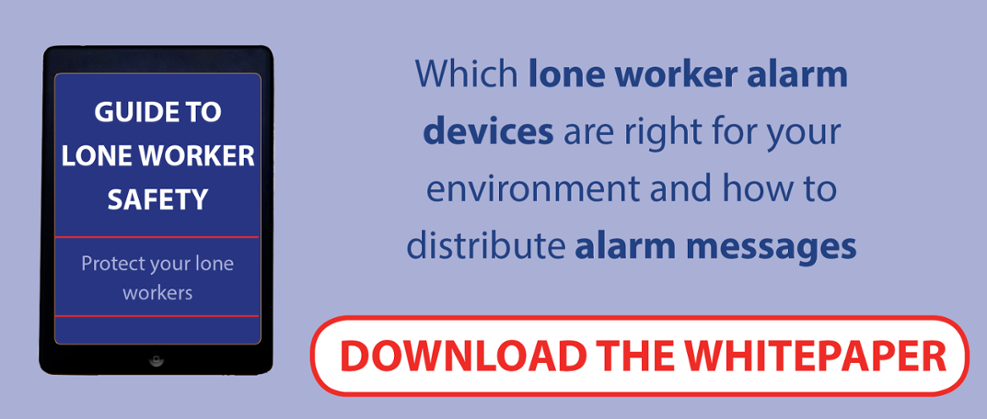
Legally, there's nothing wrong with having lone workers in your company. They serve a variety of very useful tasks: management and oversight, taking care of single-person tasks in low-need areas, cleaning, and a whole host of other necessary tasks that keep your business functioning smoothly. From factories, to agricultural environments, lone workers are everywhere. Identifying lone workers within your business and taking the steps necessary to ensure their safety, however, will keep your business flowing more smoothly, protect your lone workers from hazards, and protect your company from potential ramifications if everything doesn't go according to plan.
So here is who they are, how to identify whether your company has any and why that's important.
The Textbook Definition
The textbook definition of lone workers is those who regularly work alone, without contact from another employee or supervision. As a result, these individuals are exposed to greater risk than employees who work side-by-side with others. These individuals, as explained in our blog post on "Can you hear a lone worker calling?" can include:
- Employees who consistently and regularly work out of sight of other employees.
- Contractors whose work takes them to remote locations.
- People who work outside the normal hours of operation, often alone. These may include security workers, janitors, and others whose job duties are different than typical employees of the facility.
- Forestry and agricultural workers who regularly work far from other people.
- Maintenance workers who come in to take care of problems, especially those that other employees aren't used to seeing on a regular basis.
- Self-employed workers who periodically visit your work site.
Redefining Lone Workers
Not every lone worker is on the list of those you would automatically consider. Lone workers aren't just those who are isolated throughout their entire day, rarely coming into contact with others throughout the normal course of business. They can also be:
- Managers who frequently walk around a plant or other dangerous areas alone, particularly if they do so out of routine or without checking in with others
- Employees who work in the same area, but whose tasks routinely take them to separate areas of the workplace where they will no longer be in sight of one another
- Service workers who leave the premises and travel alone to other locations.
- Contractors who are temporary visitors at your facility.
- Employees who work different shifts than others, staying late or arriving early in order to complete their tasks.
It's important, when considering lone workers, to expand your definition so that you aren't leaving anyone out and you cater to them individually to ensure their safety.
The Hazards of Lone Working
When an accident occurs, you want everyone in the company to respond quickly. Not only do you want to be sure the employee is taken care of, you want to know that your company isn't liable for any damages that occur due to negligence. Unfortunately, as explained also by the HSA, lone workers often face greater hazards than workers within the company as a whole. Consider:
- What happens if an employee falls ill suddenly or is attempting to work in spite of illness? How would a lone worker in this situation be identified?
- What would happen if a machine malfunctioned?
- What happens if a lone worker experiences a fall on wet or uneven flooring? What if they have an accident outdoors?
- Do lone workers have adequate access to first aid materials and the facilities they need to care for themselves?
- Can members of the public or intruders access this area and pose a threat to a lone worker?
The hazards faced by lone workers are very real. Unfortunately, many businesses admit that it could take 30 minutes or more to identify the fact that a problem had arisen with a lone worker in their company, which could potentially be fatal in certain situations.
Click here to learn more about lone workers
Identifying Lone Workers
Identifying the lone workers in your company isn't as simple as walking through the facility or job area and making note of anyone who works alone, away from the oversight of coworkers and management. While these are certainly individuals who should be included on the list, there are several other questions you should ask when identifying your lone workers.
- What maintenance workers and other employees appear on an irregular basis at your place of business, often unaccompanied by others?
- How long do employees spend completing tasks that take them into areas that aren't visible by other workers?
- Is there any area in your workplace where hazardous material is dealt with without assistance?
- Are there mechanical operators in your factory or business who handle their machines on their own?
- Do you have people who leave your business and take care of tasks outside the facility without taking another employee with them?
- Who in your business comes in earlier than other employees or leaves later?
- Are employees in a shop or office often left alone with customers, without a coworker on hand? Include times when an employee must visit a back room or take care of a customer in another area.
Properly identifying the lone workers throughout your workplace is the best way to be sure that they get the appropriate care during their work days. When you know who your lone employees are, you can identify potential hazards and prevent your lone employees from being affected. Should an accident occur safety measures can be implemented to ensure that alarms are triggered, colleagues are alerted and help arrives with the lone worker in a timely fashion.
All across the UK, many employees complete their daily job responsibilities alone. In many cases, it's necessary: you don't need two employees to handle the work that one can do alone. Providing the appropriate safeguards, however, will ensure that your employees are able to successfully handle their daily job responsibilities, keep your business running smoothly, and face fewer hazards at the same time.





